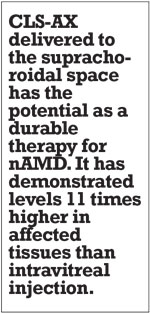| Richard Mark Kirkner, Editor |
 |
Axitinib is a tyrosine kinase inhibitor that’s been widely used to treat advanced renal cell carcinoma. Like other cancer drugs that have been adapted to treat exudative retinal disease, axitinib targets vascular endothelial growth factor. It has been shown to inhibit three VEGF receptors: VEGFR-1, VEGFR-2 and VEGFR-3.1
For renal cell carcinoma, axitinib is marketed as the oral agent Inlyta (Pfizer). Clearside Biomedical is now investigating the efficacy of an injectable suspension of axitinib for treatment in neovascular age-related macular degeneration using its proprietary suprachoroidal microinjector platform. CLS-AX has just completed dosing in the first cohort of OASIS, the ongoing Phase I/IIa clinical trial (NCT04626128).
Allen Hu, MD, a vitreoretinal specialist at Cumberland Valley Retina Consultants in western Maryland and southcentral Pennsylvania and a paid investigator for the OASIS trial, answers questions about CLS-AX.
Q: Describe the mechanism of action of axitinib and its potential for the retina.
Axitinib inhibits corneal, retinal and choroidal angiogenesis in animal models 3-7 by inhibiting VEGFR-1, VEGFR-2 and VEGFR-3. Current AMD therapies focus primarily on VEGF-A blockade and not the VEGF receptors, which may upregulate other forms of VEGF.
 |
Q: What are the potential advantages for suprachoroidal administration?
CLS-AX delivered to the suprachoroidal space has the potential as a durable therapy for nAMD. It has demonstrated levels 11 times higher in affected tissues than intravitreal injection.
Another advantage of suprachoroidal injection is the compartmentalized delivery away from unaffected tissues, minimizing vitreous floaters, the snow globe effect and corneal and anterior segment exposure.
In terms of pharmacokinetics, multiple animal models have shown prolonged duration, demonstrated by the elevated and sustained concentration of axitinib above the half-maximal inhibitory concentration (IC50) in posterior ocular tissues.
Q: What’s the protocol being used in the OASIS trial?
OASIS is a Phase I/IIa dose-escalation study to evaluate the safety and tolerability of suprachoroidally delivered axitinib over 12 weeks following an initial aflibercept injection to standardize patients to at least one dose of anti-VEGF therapy. That also allows for an extra visit to further standardize the assessment of vision and anatomic parameters. The study will consist of three planned cohorts with five subjects each.
Q: What’s been learned from TKIs in other indications that may apply in nAMD?
Axitinib inhibits VEGF receptors broadly, along with other receptors. Animal studies have shown that axitinib effectively inhibits retinal and choroidal angiogenesis in multiple preclinical models and has better biocompatibility with ocular cells than other TKIs.2
Preclinical and clinical studies have shown that broad VEGF inhibition is more promising than focused VEGF-A inhibition.2 Another preclinical study of several TKIs in wet AMD has shown that axitinib more potently inhibits neovascularization than sunitinib or sorafenib.3 RS
REFERENCES
1. Prescribing information Inlyta-axitinib, Pfizer. http://labeling.pfizer.com/ShowLabeling.aspx?id=759. Accessed March 11, 2021.
2. Giddabasappa A, Lalwani K, Norberg R, et al. Axitinib inhibits retinal and choroidal neovascularization in in vitro and in vivo models. Exp Eye Res. 2016;145:373-379.
3. Yuan X, Shin CS, Isenhart SC, Pflugfelder SC, Acharya G. Ocular drug delivery nanowafer with enhanced therapeutic efficacy. ACS Nano. 2015;9:1749-1758.



